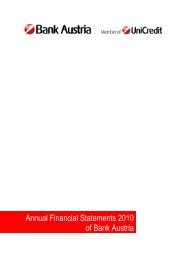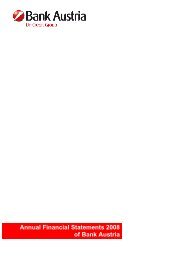Annual Financial Statements 2011 of Bank Austria
Annual Financial Statements 2011 of Bank Austria
Annual Financial Statements 2011 of Bank Austria
Create successful ePaper yourself
Turn your PDF publications into a flip-book with our unique Google optimized e-Paper software.
Management Report <strong>of</strong> UniCredit <strong>Bank</strong> <strong>Austria</strong> AG<br />
Development <strong>of</strong> UniCredit <strong>Bank</strong> <strong>Austria</strong> AG in <strong>2011</strong><br />
1. Report on business developments and the economic<br />
situation<br />
1.1. Business developments<br />
Economic situation and banking environment in our core<br />
markets<br />
The banking environment in <strong>2011</strong> was mainly determined by three<br />
factors:<br />
First, the economic slowdown: The global economy entered <strong>2011</strong><br />
with a strong momentum gathered in the period <strong>of</strong> recovery after<br />
the recession seen in 2008/2009. In the first half <strong>of</strong> <strong>2011</strong>, growth<br />
was stronger than predicted but then weakened in the remaining<br />
part <strong>of</strong> the year. Output in the industrial countries stagnated at a<br />
high level towards year-end without sliding back into recession.<br />
The economy in the euro area again benefited from the catchingup<br />
process in the Asian emerging markets. In China, growth again<br />
reached 9%, despite restrictive measures. Overall, the emerging<br />
markets recorded economic growth <strong>of</strong> over 6%. This trend mainly<br />
benefited the highly competitive European core countries, including<br />
<strong>Austria</strong>, and CEE countries whose industrial sector is closely<br />
integrated. Developments within the euro area were increasingly<br />
disparate in <strong>2011</strong>, with marked differences between the core and<br />
the periphery. Germany achieved average annual growth <strong>of</strong> over<br />
3%, while the economies <strong>of</strong> Spain and Italy grew by only 0.5%. The<br />
strong increase in core Europe reflected a strong momentum<br />
continuing from the previous year and an excellent performance in<br />
the first quarter <strong>of</strong> <strong>2011</strong>. In the euro area as a whole, economic<br />
growth weakened from an annualised 3.1% in the first quarter to a<br />
slight decline in the fourth quarter; the average figure for <strong>2011</strong> was<br />
1.6%.<br />
Second, the government debt crisis: Government debt<br />
accumulated over several decades, compounded by fiscal-policy<br />
measures taken to handle the crisis in 2008/2009, was suddenly<br />
seen by investors as unsustainable, especially against the<br />
demographic background and structurally weak growth in the<br />
mature industrial countries. The unprecedented loss <strong>of</strong> confidence<br />
was triggered by the protracted controversy over the US debt limit<br />
in the first half <strong>of</strong> <strong>2011</strong> and by the inclusion, at the end <strong>of</strong> July<br />
<strong>2011</strong>, <strong>of</strong> a partial debt waiver by private creditors in the second<br />
support package for Greece. This quickly led to doubts about the<br />
sustainability <strong>of</strong> debt in other highly indebted countries. Irrespective<br />
<strong>of</strong> the fundamentals, rolling over government debt <strong>of</strong> these<br />
countries via the market became a problem, with interest rate<br />
spreads reaching high and partly prohibitive levels. Despite the<br />
countermeasures taken by the ECB, sovereign bonds suddenly<br />
became high-risk bonds, with a strong impact on the overall<br />
interest rate structure.<br />
Third, stricter regulation <strong>of</strong> the banking sector against the<br />
background <strong>of</strong> more difficult funding conditions: in view <strong>of</strong> the<br />
close interdependence <strong>of</strong> banks and their home countries, the<br />
government debt crisis rapidly spread to banks. Liquidity and<br />
medium-term funding via banks’ own issues became much more<br />
expensive, and so did the raising <strong>of</strong> equity capital in view <strong>of</strong> the<br />
sharp fall in prices <strong>of</strong> bank shares (EuroStoxx/<strong>Bank</strong>s down by 38%<br />
year-on-year). Money markets also saw a decline in banks’<br />
confidence in each other; as a result, clearing took place via the<br />
ECB euro system. These developments were accompanied by<br />
increasing regulatory pressure on banks:<br />
Based on stress tests carried out by the European <strong>Bank</strong>ing<br />
Authority in March/June and October/December, rules under the<br />
Basel 3 package were tightened and their application was brought<br />
forward, including the equity capital definitions and the target <strong>of</strong> a<br />
Core Tier 1 capital ratio <strong>of</strong> 9% to be met by the middle <strong>of</strong> 2012. As<br />
a result, banks had to build substantial risk buffers and increase<br />
their core capital. However, after reevaluating the medium- to longterm<br />
outlook in their markets, banks started to adjust their<br />
business models to the new environment in <strong>2011</strong>. In many cases,<br />
these efforts involved a targeted reduction <strong>of</strong> assets and a focus on<br />
core commercial banking, especially the attraction <strong>of</strong> deposits, as<br />
well as strengthening the equity capital base.<br />
The stark contrast between the first and the second half-year<br />
was reflected in economic trends and in all segments and key<br />
indicators <strong>of</strong> financial markets. In the first half <strong>of</strong> <strong>2011</strong>, strong<br />
economic growth coupled with inflationary pressure resulting from<br />
trends in commodity prices prompted the European Central <strong>Bank</strong><br />
to raise key interest rates twice – at the beginning <strong>of</strong> March and as<br />
late as the beginning <strong>of</strong> June – to a level <strong>of</strong> 1.5%. When the<br />
government debt crisis came to a head in July/August, this<br />
triggered an abrupt trend reversal in all market segments. The<br />
credit ratings <strong>of</strong> the GIIPS countries (Greece, Ireland, Italy,<br />
Portugal and Spain) were downgraded, with Greece falling to CCC<br />
(S&P) on 13 June. On 18 July, the US was placed on review for<br />
possible downgrade, losing its AAA rating on 6 August, for the first<br />
time since 1941. Following the publication <strong>of</strong> the stress test<br />
results by the EBA on 15 July <strong>2011</strong>, and subsequent to the<br />
European Council decisions <strong>of</strong> 21 July <strong>2011</strong>, which for the first time<br />
provided for a voluntary remission <strong>of</strong> debt as part <strong>of</strong> the second<br />
support package for Greece, market strain escalated. Prices for<br />
Greek government bonds (mid-prices in per cent, five-year) fell<br />
from 75.45 (year-end 2010) via 53.42 (end <strong>of</strong> June <strong>2011</strong>) and<br />
42.67 (end <strong>of</strong> September <strong>2011</strong>) to 23.25 (year-end <strong>2011</strong>); yields,<br />
which are <strong>of</strong> little informative value, were around 50%.<br />
Scepticism spread from debtor countries like Greece and Portugal<br />
to such highly indebted countries as Italy and Belgium, and later<br />
also France, which were previously seen as being beyond doubt.<br />
The CDS spreads on long-term government bonds <strong>of</strong> the GIIPS<br />
group <strong>of</strong> countries – in pre-Lehman times around 60 basis points<br />
(bp) and in the middle <strong>of</strong> 2009 still below 100 bp – rose from an<br />
average <strong>of</strong> about 400 bp in the middle <strong>of</strong> <strong>2011</strong> to 1,200 bp by the<br />
end <strong>of</strong> the year. The creditworthiness <strong>of</strong> core European countries<br />
enjoying the top rating also came to be questioned from<br />
November/December onwards, including that <strong>of</strong> <strong>Austria</strong> with a<br />
reference to the banks’ large exposure to Hungary.<br />
In summer <strong>2011</strong>, stock markets tumbled worldwide and showed<br />
volatile trends in the remaining part <strong>of</strong> the year. By the middle <strong>of</strong><br />
August, the world share index MSCI had fallen by 18%; at the end<br />
<strong>of</strong> <strong>2011</strong> it was 8.5% lower than a year earlier. The EuroStoxx index<br />
was down by 26% from the end <strong>of</strong> July to the lowest point in <strong>2011</strong><br />
(and down by 18% in a comparison <strong>of</strong> year-end <strong>2011</strong>/2010 levels),<br />
the ATX index lost even 38% (or 36% based on year-end levels).<br />
The flight to quality saw benchmark bonds (denominated in US<br />
dollars and euros) gaining in value. The 10-year euro benchmark<br />
yield reached its low at 1.64% on 23 September <strong>2011</strong> and was<br />
only slightly higher at the end <strong>of</strong> the year (1.86% compared with<br />
2.97% at the end <strong>of</strong> 2010).<br />
At the end <strong>of</strong> July, spot and forward rates in money markets fell<br />
far below key interest rates levels, which were reduced to 1% much<br />
later, at the beginning <strong>of</strong> November and in early December. The<br />
ECB intensified its expansionary monetary policy at the beginning<br />
<strong>of</strong> August by resuming three-month and six-month long-term<br />
tenders with full allocation, and increasing purchases <strong>of</strong><br />
government bonds and covered bonds. An essential sign <strong>of</strong> easing<br />
was the first <strong>of</strong> two announced three-year tenders in December<br />
<strong>Bank</strong> <strong>Austria</strong> – <strong>Annual</strong> <strong>Financial</strong> <strong>Statements</strong> <strong>2011</strong> 185
















